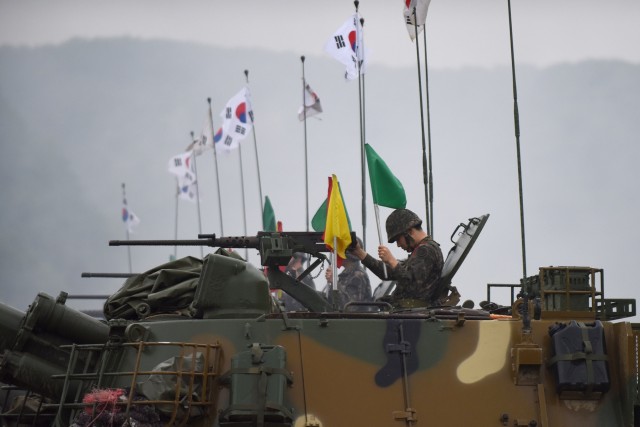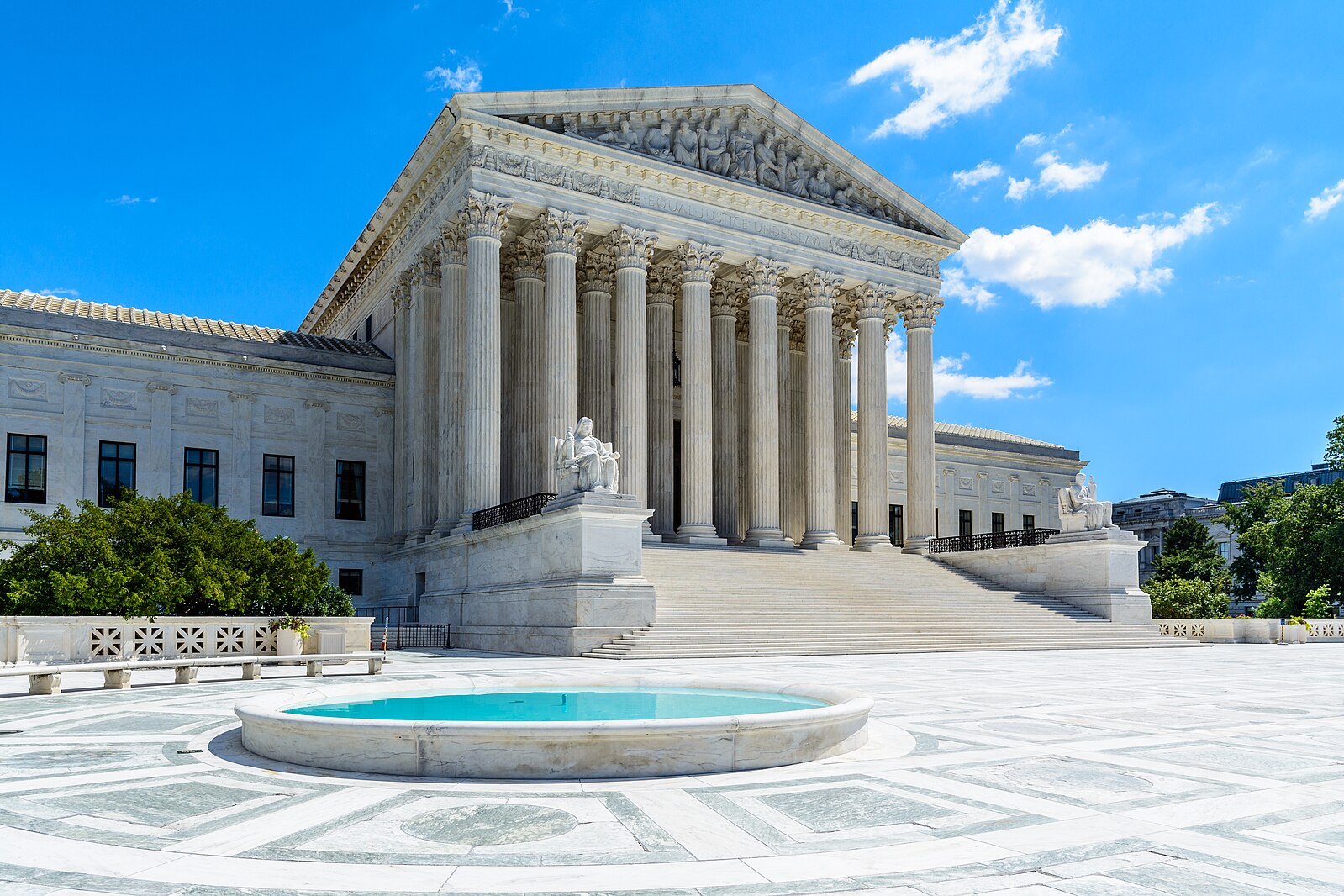The House Examines U.S. Defense Policy on the Korean Peninsula
On Jan. 28, the House Armed Services Committee held a hearing on U.S. defense policy in the Korean peninsula that examined the administration’s efforts to strengthen the U.S. alliance with South Korea while deterring and securing the denuclearization of the countries’ shared foe in the north.

Published by The Lawfare Institute
in Cooperation With

On Jan. 28, the House Armed Services Committee held a hearing on U.S. defense policy in the Korean peninsula that examined the administration’s efforts to strengthen America’s alliance with South Korea while deterring and securing the denuclearization of the countries’ shared foe in the north.
The hearing comes at a particularly tense moment in Washington’s relations with Seoul and Pyongyang. In early December, North Korean leader Kim Jong-un reportedly tested a new engine for his regime’s long-range ballistic missiles. And on Dec. 31, 2019, America’s Special Measures Agreement (SMA) with South Korea—an annual, burden-sharing deal that determines how Washington and Seoul divide the costs of stationing U.S. forces in South Korea—expired with little prospect of an immediate replacement. Negotiations over the 2020 SMA have stalled as the countries debate the Trump administration’s controversial proposal for a new SMA, which asks South Korea to increase its share of the annual financial burden by several billion dollars.
The armed services panel heard testimony on these and other issues from two senior Defense Department officials: John Rood, the undersecretary of defense for policy, and Lt. Gen. David Allvin, the director for strategy, plans and policy at the Joint Chiefs of Staff.
In their joint written remarks, Rood and Allvin outlined the Pentagon’s priorities on the peninsula. The Defense Department seeks to strengthen the U.S. alliance with South Korea, which Rood and Allvin referred to as the “linchpin” of peace in the Indo-Pacific region. The department is also preparing Seoul to confront future defense challenges by backing a robust military modernization program that will culminate in the Pentagon’s transferring leadership of Combined Forces Command—which oversees the joint American-South Korean force tasked with defending South Korea—from a U.S. officer to a South Korean officer.
With regard to North Korea, Rood and Allvin described the Defense Department’s role as supporting the administration’s whole-of-government effort to secure the denuclearization of the Kim regime while deterring further aggression by it. Rood and Allvin explained that this role has required the department to perform a precarious balancing act: suspending “certain large-scale exercises” to make room for denuclearization talks while simultaneously maintaining sufficient force readiness and “field[ing] the necessary capabilities” to ensure the U.S. maintains and negotiates from a position of strength.
From the outset of the hearing, lawmakers questioned the wisdom of the administration’s push for South Korea to pay an additional several billion dollars in this year’s SMA. Rep. Adam Smith, the committee chairman, worried that the proposal will damage Washington’s relationship with Seoul. Rep. Gil Cisneros worried that the damage would extend beyond mere diplomatic harm and would rob South Korea of funds it might otherwise have spent on developing its own defense capabilities.
Rood confessed to sharing Smith’s concerns and told the committee that the Departments of State and Defense will not conduct the SMA negotiations in a way that unduly strains the U.S.-South Korean alliance. But the undersecretary also pushed back against the notion that the administration has asked too much of its ally. Echoing Defense Secretary Mark Esper’s remarks on the subject, Rood described South Korea as one of the wealthiest countries on earth and said the administration has assessed that Seoul can afford the SMA contribution increase.
Cisneros remained unconvinced, and he countered with two more questions—asking, first, whether the U.S. intends to withdraw its forces from South Korea if Seoul refuses to pay up and, second, whether the dispute over burden sharing has prompted North Korea to “act out” to exploit a perceived fissure in the U.S.-South Korean alliance. Rood largely evaded the former question, noting simply that the U.S. has navigated difficult SMA negotiations before and expects to resolve this latest round soon. As for the question concerning Pyongyang’s response to the impasse in negotiations, the undersecretary acknowledged that the administration must be “conscious” not to send an “inadvertent signal” to the Kim regime that Washington’s commitment to Seoul is wavering.
Indeed, Rood emphasized the depth of the U.S. and South Korea’s interdependence and shared aims, and offered a clear-eyed assessment of the adverse consequences of further delays in finalizing the 2020 SMA. The undersecretary noted that the SMA funds the salaries of South Korean employees on U.S. bases. Once the funding from the 2019 agreement dries up, Rood said, the government in Seoul will have to furlough those employees, which will affect base operations.
Representatives’ rebukes were not aimed only at America’s behavior, however. Several lawmakers criticized South Korea for coming precipitously close—over strident U.S. objections—to withdrawing from its intelligence-sharing pact with Japan, the General Security of Military Information Agreement (GSOMIA). Rep. Jim Banks asked whether the eroded relationship between South Korea and Japan has caused the countries to fail to share critical intelligence with each other. Allvin answered with an emphatic no, but Rood conceded that the GSOMIA has hardly worked as well as the U.S. would like. The undersecretary added that the administration continues to emphasize to both Japan and South Korea the vital importance of the pact.
Several committee members also expressed concern that the suspension of large-scale military exercises might hamper the readiness of American and South Korean forces. Allvin was quick to disabuse lawmakers of that notion. Of the roughly 307 training events scheduled to take place since the president suspended larger exercises in June 2018, U.S. forces have executed 273, or more than 88 percent of them.
Allvin repeatedly praised Gen. Robert Abrams, the commander of U.S. Forces Korea, for ensuring that the U.S. military complies with the president’s suspension order while also making sure to maximize the amount of training that American and South Korean soldiers can undertake. Abrams, Allvin emphasized to the committee, would never allow the joint forces to slip below the minimum level of readiness necessary to confront and deter North Korean aggression.
Rep. Austin Scott inquired about a separate aspect of force readiness: whether Seoul will be prepared to assume leadership of Combined Forces Command in 2022, the year South Korean President Moon Jae-in seeks to make the transition to South Korean leadership of the Combined Forces. Allvin responded that, while the Pentagon hopes the transfer of leadership will occur in 2022, that transition is “conditions-based,” and the Defense Department has put “measures” in place to ensure the transition is not rushed. According to Rood and Allvin’s joint written remarks, South Korea has committed to a 7 percent hike in its defense spending; the “expansion of intelligence, surveillance, and reconnaissance assets and strike capabilities; and comprehensive missile defense upgrades” to “meet the requirements necessary to assume operational control” of the command.
Rep. Vicky Hartzler pressed for information about a particular U.S. and South Korean capability: subterranean warfare, or tunnel warfighting. The congresswoman said that during a visit to South Korea several years ago, the U.S. Army service members with whom she spoke told her that any war with North Korea would likely involve fighting underground—seemingly a reference to the network of bunkers and tunnels the North Koreans have dug, some of which cut beneath the border and lead uncomfortably close to Seoul.
Hartzler asked Allvin about the training that U.S. and South Korean forces have undertaken to prepare to wage war below ground, and she pressed the lieutenant general for his sense of U.S. and South Korean readiness for this form of warfighting. Allvin took the questions for the record and promised to get back to Hartzler with more information.
Rather than dwell on the prospect of war with the north, lawmakers spent more time at the hearing questioning the witnesses on how Washington can pressure Pyongyang to resume denuclearization talks. Rood cited the Trump administration’s “maximum pressure campaign”—which comprises a multilateral economic sanctions regime; diplomatic efforts to convince China to push Pyongyang to negotiate toward denuclearization; and maritime efforts to spot, prevent, and occasionally interdict ship-to-ship transfers of illicit North Korean coal and petroleum exports. Rood emphasized the importance of maintaining maximum pressure on the regime and expressed doubt that Pyongyang would return to the negotiating table if the U.S. removed that pressure.
Rep. Ro Khanna offered a different perspective. He argued that while the U.S. must use the stick of maximum pressure, it can also offer Pyongyang a carrot: a declaration of peace. When the Korean War ended in 1953, it ended with an armistice that remains in place to this day, not with a peace deal. Khanna thus asked Rood if the U.S. could declare peace with North Korea, formally and finally ending the war, in a good-faith gesture to encourage Kim to return to the negotiating table. Khanna suggested that the U.S. could make an announcement of peace with Pyongyang first and then hammer out the finer details of the declaration in later talks.
While acknowledging that the original armistice was not intended to last as long as it has, Rood seemed skeptical of Khanna’s proposal. The undersecretary noted that he would have to consult with Secretary of State Mike Pompeo, whom he said would be in charge of the tactical decision of when the U.S. should offer the North Koreans a formal declaration of peace. Khanna nevertheless urged the undersecretary and the administration to consider his proposal, especially since President Moon and other senior South Korean officials support the idea.
Most lawmakers seemed to think that maintaining strong missile defense capabilities in the U.S. will remain key until Washington secures the denuclearization of the Kim regime, a formal peace deal or reductions in Pyongyang’s missile arsenal. Rep. Doug Lamborn was particularly focused on this, noting that Northern Command has assessed that the risk of a North Korean missile attack on the U.S. homeland will increase substantially around 2025, given the rate at which Pyongyang is improving its intercontinental ballistic missile capabilities. Lamborn pressed Rood on whether it would be useful to create a missile defense “underlayer” in the U.S. This would mean complementing America’s existing domestic missile defense capabilities with a Standard Missile-3 Block IIA system or an extended-range Terminal High Altitude Area Defense system.
Rood said he believed such an underlayer could make a “substantial contribution” to America’s defense, but he noted that the underlayer could not serve as a replacement for America’s longer-range missile defenses, such as the ground-based interceptors the U.S. has deployed in Alaska.





